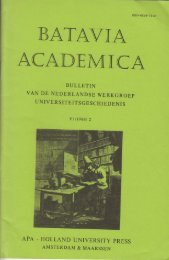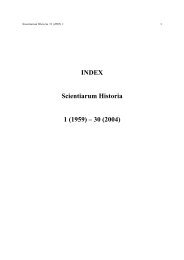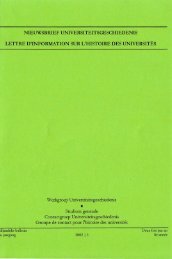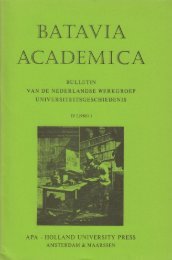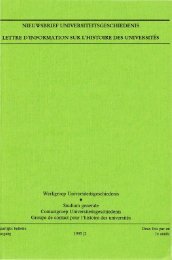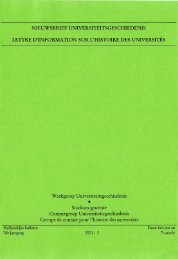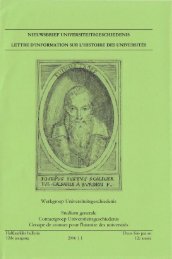the ocular harpsichord of louis-bertrand castel - Gewina
the ocular harpsichord of louis-bertrand castel - Gewina
the ocular harpsichord of louis-bertrand castel - Gewina
You also want an ePaper? Increase the reach of your titles
YUMPU automatically turns print PDFs into web optimized ePapers that Google loves.
66 Maarten Franssen<br />
Tieck, in his turn, was a dominating influence on E.TA. H<strong>of</strong>fmann, one <strong>of</strong> <strong>the</strong><br />
outstanding figures <strong>of</strong> German Romanticism, and it is in his writings that a last<br />
mention <strong>of</strong> <strong>the</strong> <strong>ocular</strong> <strong>harpsichord</strong> can be found in Germany. On <strong>the</strong> one hand,<br />
H<strong>of</strong>fmann admitted that "tone is in music exactly what colour is in painting". On<br />
<strong>the</strong> o<strong>the</strong>r hand he rejected <strong>the</strong> kind <strong>of</strong> formal colour music <strong>the</strong> <strong>ocular</strong> <strong>harpsichord</strong><br />
apparently performed. Melody and harmony in music could only be<br />
compared with <strong>the</strong> full bloom <strong>of</strong> nature itself:<br />
It is not <strong>the</strong> colour green, it is <strong>the</strong> wood with <strong>the</strong> graceful beauty <strong>of</strong> its foliage, that engenders<br />
<strong>the</strong> thrill and sweet melancholia in our breast. The deep blue <strong>of</strong> <strong>the</strong> sky will soon start to<br />
appear empty and sad to us when <strong>the</strong>re are no clouds rising in myriads <strong>of</strong> changing images.<br />
Apply this to art and realize how soon you would be tired <strong>of</strong> seeing <strong>the</strong> most beautiful colours<br />
without any form, and how briefly sight would be tickled by <strong>the</strong>m. Think <strong>of</strong> <strong>the</strong> silly <strong>ocular</strong><br />
<strong>harpsichord</strong> <strong>of</strong> Fa<strong>the</strong>r Castel! - And in music <strong>the</strong> same is true. The tone will only deeply affect<br />
<strong>the</strong> soul when it has formed itself into melody or harmony, in short, into music."*<br />
It is an indication <strong>of</strong> <strong>the</strong> aes<strong>the</strong>tic changes near <strong>the</strong> end <strong>of</strong> <strong>the</strong> eighteenth<br />
century as described by Neubauer and Barry, that Heinse and Tieck speak <strong>of</strong><br />
fantasy and <strong>the</strong> imagination as <strong>the</strong> vehicle <strong>of</strong> artistic delight, and <strong>the</strong> Romantic<br />
synaes<strong>the</strong>tic imagery clearly has a primarily evocative function ra<strong>the</strong>r than a<br />
descriptive one. However, for all <strong>of</strong> <strong>the</strong>se early Romantics, music is still standing<br />
very much apart; a harmony and melody <strong>of</strong> colours <strong>the</strong>y find in nature itself,<br />
something <strong>the</strong>y would not have deemed appropriate for music at all.<br />
Meanwhile, <strong>the</strong> word play <strong>of</strong> synaes<strong>the</strong>sia was developed and used especially<br />
yellow to <strong>the</strong> clarinet, scarlet to <strong>the</strong> trumpet, pink to <strong>the</strong> oboe, kermes to <strong>the</strong> flute, purple to <strong>the</strong><br />
horn and violet to <strong>the</strong> basscxsn. Of course, <strong>the</strong> notion <strong>of</strong> a well-defined colour scale had at this<br />
stage <strong>of</strong> <strong>the</strong> historical development completely drifted out <strong>of</strong> <strong>the</strong> picture. See Gauthier d'Agoty,<br />
Observations, pp. 174-175; Hellwag, "Vergleichung," and his letter to Kant <strong>of</strong> December 1'790, in<br />
Kant, Briefwechsel, vol. 2, pp. 194-204. For H<strong>of</strong>fmann, see Goe<strong>the</strong>'s Malerialien zur Geschichle der<br />
Farbenlehre, pp. 395-399. Gauthier d'Agoty and H<strong>of</strong>fmann developed <strong>the</strong>ir ideas in reaction to<br />
Castel's <strong>ocular</strong> <strong>harpsichord</strong>, which <strong>the</strong>y rejected all <strong>the</strong> more vehemently for it. Tieck just as well<br />
called it a "kindische Spielwerk" (p. 243). A list <strong>of</strong> comparisons <strong>of</strong> colours with musical instruments<br />
similar to H<strong>of</strong>fmann's, developed independently by <strong>the</strong> Englishman William Gardiner, was given in<br />
The lives <strong>of</strong> Haydn and Mozan (London, 1817), <strong>the</strong> English translation <strong>of</strong> <strong>the</strong> original French book<br />
by L.-A.-C. Bombet, a pseudonym <strong>of</strong> M.-H. Beyle, better known as Stendhal. See <strong>the</strong> note <strong>the</strong>re on<br />
p. 255.<br />
' H<strong>of</strong>fmann, "Ein Brief des Kapellmeisters Johannes Kreisler" (1819), in Werke, vol. 14, pp. 93-<br />
94; "Der Ton ist in der Musik ganz und gar dasselbe was in der Malerei die Farbe ... lis ist nicht<br />
die Farbung des Griinen, es ist der Wald mit der anmutigen Pracht seines Laubes, der in unserer<br />
Brust das Entziicken weckt und die siiBe Wehmut. Das tiefe Blau des Himmels diinkt uns bald ode<br />
und traurig, steigen nicht die Wolken auf in tausend wechselndcn Bildern: Wendet das auf die<br />
Kunst an und denkt Euch, Wiirdiger, wie bald es Euch ermiiden, oder was fiir einen momentanen<br />
Sinneskitzel es von Haus aus erregen wiirde, die schonsten Farben ohne Gestaltung zu schauen? -<br />
Denkt an das lappische Farbenklavier des Paters Castel! - Und nun i.st's ebenso in der Musik. Der<br />
Ton wird nur dann erst tief unser Gemiit ergreifen, wenn er sich zur Melodic oder Harmonie, kurz,<br />
eben zur Musik gestaltet."





